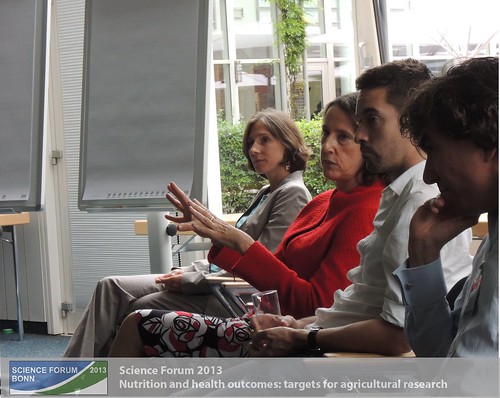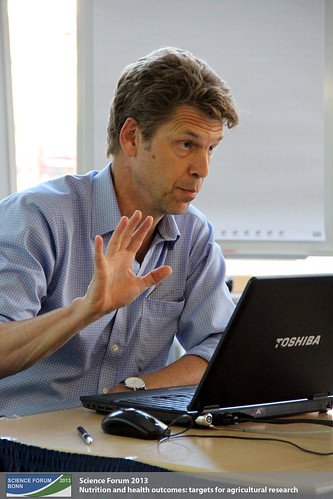Blogs
How soon do you want to die? It´s up to you!
Thu, 09/26/2013 - 09:46 — Viviane Meyer
In the session about NCDs (non-communicable diseases), diet-based problems were illustrated and discussed and the link to agricultural practices was analysed. Evidence was gathered and possibilities for future agricultural research were presented under the guidance of Mr. K. Srinath Reddy. Some outcomes of this session were that people get severe illnesses such as cancer and diabetes due to the food each person eats- so you are what you eat- namely fat and ill or slim and healthy.
Bridging the gender gap
Thu, 09/26/2013 - 01:36 — Louisa Wong
According to the World Economic Forum (WEF) report, Lesotho is ranked first in Africa for bridging the gender gap and eighth in the entire world - with 95% of women able to read and write, compared with 83% of men. Women can take up important positions in the job market and can be as competitive as men. It’s only one side of the story.
 Lynn Brown was sharing her point of view about gender sensitive agriculture in the Breakout session about under-nutrition
Lynn Brown was sharing her point of view about gender sensitive agriculture in the Breakout session about under-nutrition
 Lynn Brown was sharing her point of view about gender sensitive agriculture in the Breakout session about under-nutrition
Lynn Brown was sharing her point of view about gender sensitive agriculture in the Breakout session about under-nutrition
Let’s keep it informal!
Wed, 09/25/2013 - 17:35 — Kirstin Ohlendorf
In the breakout session on “Leveraging Value Chains for better nutrition and food safety: Lessons for CGIAR Research”, Delia Grace from ILRI in Nairobi Kenya highlighted the importance of the informal sector. Research indicates that in many low income countries, e.g. milk is marketed via informal markets and this trend to supermarkets is not valid for all countries – also not with regards to consumer preferences.
Furthermore the informal sector is highly relevant for women who can sell their products in an informal way, but at the same time highly risky in terms of food safety.
Is the formal sector better?
What the Scientific world itself eats
Wed, 09/25/2013 - 17:27 — Eva Hilt
Within the unconventional setting of wild animals of the African Savannah and images of the foods of people all around the globe, the researchers and participants of the Science Forum were enjoying the conference dinner on Monday evening.
There is nothing like fish
Wed, 09/25/2013 - 16:05 — Rahel Wyss
If fish would be removed from peoples’ diet in Bangladesh, nothing else could replace that valuable nutrient-rich food. 70% of the Bangladeshi population is eating fish 7 to 14 times within two weeks. Studies prove the positive impact of small fish species on an improved dietary diversity. Moreover, the most important aspect of fish in terms of nutrition is that fish enhances the uptake of micronutrients from food eaten in the same meal. Not to forget, that consumers like the flavour and the added taste of fish to their meal.
It should be a women’s world?
Wed, 09/25/2013 - 15:52 — Kirstin Ohlendorf
The presentation Agricultural pathways to improved nutrition: getting the policies right by Prabhu Pingali focused on the creation of a policy environment which supports the Agriculture - Nutrition Nexus – instead of the current Agriculture versus Nutrition Silos!
Questionable results from breakout session
Wed, 09/25/2013 - 15:49 — Eva Hilt
The problem of how to align agricultural and food policies with nutritional and health targets had been examined from very distinct angles during the first 3 hours Policy and Institutional Approaches in nutrition-sensitive agriculture slot on Monday. It became clear, that the presented approaches themselves so far are not aligned, so that there seems to be huge potential for high quality research which helps to get an idea on how ‘multipolicy’ approaches can make an effective contribution to nutritional improvement.
 The following article is a collection of questions, as a source of inspiration if you wonder what to do after the conference or in your graduation thesis…
The following article is a collection of questions, as a source of inspiration if you wonder what to do after the conference or in your graduation thesis…
 The following article is a collection of questions, as a source of inspiration if you wonder what to do after the conference or in your graduation thesis…
The following article is a collection of questions, as a source of inspiration if you wonder what to do after the conference or in your graduation thesis…
Trees, diets and urban planners?
Wed, 09/25/2013 - 15:42 — Paulina Campos We might often think of trees from an ecological point of view, delivering ecosystem services such as carbon sequestration or preventing soil erosion. But what about their dietary value? How can they contribute to improve food security and nutrition? Do children in areas with more trees have more diverse diets? Amy Ickowitz from the Center for International Forestry Research (CIFR) addressed these questions during her presentation “Role for forests for nutrition” during the session “Diet diversification”.
We might often think of trees from an ecological point of view, delivering ecosystem services such as carbon sequestration or preventing soil erosion. But what about their dietary value? How can they contribute to improve food security and nutrition? Do children in areas with more trees have more diverse diets? Amy Ickowitz from the Center for International Forestry Research (CIFR) addressed these questions during her presentation “Role for forests for nutrition” during the session “Diet diversification”.




